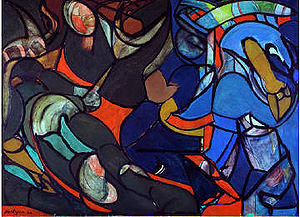American Painting
American painting encompasses a wide variety of paintings, including portraits and landscapes, created in America since its colonization.
| “ | Most Americans have fixed their eyes so exclusively on European painting that they are unaware of their own; they do not realize that we are the inheritors of a tradition of which we may well be proud. Flourishing on these shores for almost three centuries, our painters have expressed with brilliance the life and the dreams of the thirteen Colonies and the expanding United States. They may face the future with confidence based on strength. [1] | ” |
Contents
Colonial Period and The Eighteenth-Nineteenth Century
Painting in American colonial period consisted mainly of portraits. John Smibert, America's first well-trained artist, landed at Newport in 1729. Robert Feke painted the beauty of the aristocratic yearnings of Colonial society. Benjamin West (1738 - 1820) was a Neoclassical painter; West had an important leadership and influence on later artists; he had a long list of American students that later became famous painters.
Charles Willson Peale was the patriarch of the The Peale Family, the First Family of American art; portrait painter, Charles Willson Peale exerted a major influence on American painting through his own work and that of his sons, brothers and nieces; Rembrandt Peale, his son, was also a remarkable painter; they contributed in a large way to the growth of American artistic interests and institutions. [1]
Gilbert Stuart and John Singleton Copley painted emblematic portraits. John Trumbull is known as the artist of the American Revolution.
Edward Savage The Washington Family, ca. 1790.
John Marshall by Henry Inman, 1832.
The Nineteenth Century
Portraiture was also important but landscapes and folk customs began to express in this period. The first painting school of American art was the Hudson River of landscape painters (The Hudson River School style involved carefully detailed paintings with romantic, almost glowing lighting); Asher B. Durand (1796-1886) and Thomas Cole (1801-1848) were prominent artists of this School. Frederic Edwin Church (1826 – 1900) was also a landscape painter. He was a central figure in this Hudson River School. Albert Bierstadt was also part of the Hudson River School (not an institution but rather an informal group of like-minded painters).
| “ | By the 1830s, landscape painting had become the vehicle for depicting a national identity. Throughout the rest of the century, the depiction of the American land took a variety of forms - as mysterious and sublime wilderness, a new territory requiring scientific documentation, the pioneers' territorial and natural destiny, or as the individual's private retreat. [2] | ” |
In the late 1880s, Impressionism appeared in America. Theodore Robinson, Mary Cassatt and Childe Hassam are examples of this School. James Abbott McNeill Whistler worked mainly in Europe; he was a precursor of abstract art.
The Coast of Labrador by William Bradford, 1866.
Storm in the Mountains by Albert Bierstadt, 1870.
Max Schmitt in a Single Scull by Thomas Eakins, 1871.
The Gross Clinic by Thomas Eakins, 1875.
Gate of Shehal, Morocco by Edwin Lord Weeks, 1880.
An Arizona Sunset Near the Grand Canyon, by Thomas Moran, 1898.
The Gulf Stream by Winslow Homer, 1899.
The Twentieth Century

Noted painters from this period include: William Henry Jackson, Edward Hopper, Georgia O'Keeffe, Thomas Hart Benton, Grant Wood, Henry Ossawa Tanner, Jackson Pollock, Jacob Lawrence, Alma Thomas, Sam Francis, Andy Warhol, Roy Lichtenstein, Jasper Johns, Martin Puryear, Ian Hornak and Ronnie Landfield. Willem de Kooning, was a Dutch immigrant painter; his style came to be referred as Abstract Expressionism, and The New York School.
| “ |
Andy Warhol and Roy Lichtenstein were exploring alternatives to abstract expressionism with subjects drawn from popular culture and a style informed by mass mechanical reproduction. [3] |
” |
Nighthawks by Edward Hopper, 1942.
Number 18 by Jackson Pollock, 1950.
False Start by Jasper Johns, 1959.
Georgica pond at Sunset by Ian Hornak, 1973.
Unknown by Sam Francis, 1990.
See also
- Gallery of American Masterpieces
- American History Painters
- American landscapes painting
- Painting Galleries
- English Painting
- Famous landscape paintings
- Famous Art
- Clementine Hunter
External links

- A Short History of American Painting
- National Gallery of Art
- Masterpieces of American Art, 1770-1920 From the Detroit Institute of Arts.
- The Hudson River School
- American History Painters
- Black American Artists
References
- ↑ Foreword Pocket History of American Painting by James Thomas Flexner.
- ↑ Masterpieces of American Art
- ↑ MODERN AND CONTEMPORARY PAINTING AND SCULPTURE



























